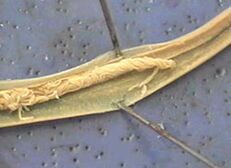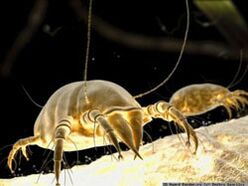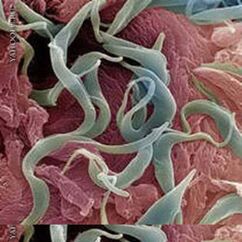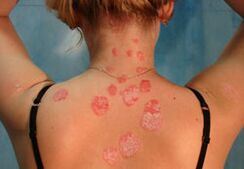Many people who lead a healthy lifestyle have health disorders due to the presence of parasites.The highlighting of the body (correct nutrition, physical exercises, cardity of hardship) without eliminating the body from parasites does not throw a pronounced positive effect.According to the World Health Organization, helminths are not only located in the stomach intestine tract, but also in the vital organs: brain, heart, lung, liver, kidneys.Helminthen distinguishes special substances in the processes of their lives - toxins that are strong poisons and allergens.It is the simplest, mushrooms and helminths that are the trigger mechanism for many chronic diseases: cholecystitis, cholelithiasis, pancreatitis, colitis, diabetes mellitus, bronchial asthma in topical dermatitis.

Chronic fatigue, irritability and fear, hyperactivity in children, anemia, brittle nails and hair, problem skin, headache, appetite disorders, reduction in immunity - this can be the signals of the current disease.With a long stay of parasites in the human body, the immune system suffers strongly.In the process of constant struggle with foreign antibodies, there is exhaustion, ie the development of secondary immune deficiency.The disease with parasites leads to hypovitaminosis, the exhaustion of micro elements: potassium, copper, manganese, selenium, zinc, magnesium, silicon;Violation of hematopoiesis, hormonal failure and vascular permeability is violated and protection against cancer cancer is suffering.
For thousands of years, people have received natural active substances, mainly vegetable food, antimicrobial, anti -parasitic and antiviral.A decrease in the consumption of wild plants, fruit, berries, replacement of vegetables and fruit, thermal and industrial treatment led to a reduction in the consumption of natural volatile and antibiotics.As a result, a person was easily prey for many microorganisms.The intensive development of the drug industry, which produces antibiotics, led to a reduction in immunity.
Determination of parasites

Parasites (from Greek. Parasitos - an overlap, a parasite) - lower plant and animal organisms that live outside or within another organism (owner) and eat at its expense.Parasites emerged in the process of historical development of organisms from freely living forms.Their adaptation to certain living conditions included the simplification of their organization, the development of special fixation organs, the increased development of the genital organs, the breathing, which enables it to exist in a participating environment.The parasites include many helminths, fungi, viruses, protozoa, worms, crustaceans, spider luggages and insects.The owners of parasites can be bacteria, simplest, plants, animals and humans.Parasites are subject to a complex development cycle: Sometimes you need a change from 2-3 owners whose bodies (helminths pass the larval stages) or permanently (helminths are ripe, invasive).Parasites cause the weakening and exhaustion of the host body and cause a number of diseases.
Helminers can parasitate in all tissues and organs of a person, but the most common place of their localization is the food wing.Bull and pork tapeworm, a wide tape are defined in the upper small intestine and also parasitically ascaris.The dwarf tab is mainly located in the lower third of the small intestine, the Vlasov - in the large intestine, in the opistorchis - in the gall passages of the liver and channels of the pancreas, the needle races - in the lower parts of the thin and in all parts of the large intest.The distribution of different types of helminths along the digestive tract in search of the cheapest living conditions offers you the individual survival and creates the conditions for developing several types in the body of a person.
classification
By distribution:
- Ubiquette - meet everywhere.
- Tropics - distributed in tropical climate zones.
According to biological and epidemiological characteristics: Geohelminthen - a disease in which helminths first develop in the human body and then on a non -living substrate, more often in the soil.Biohelminths are an illness in which a biological cycle of helminth development, with the exception of a person, necessarily takes place in the body of other living things.Differentiate between the last owners, in whose bodies, helminths develop for sexually mature and intermediary level, whereby the parasite is located in the stadium of the larva or its reproduction is not sexual.One person is more often the last host, less often - medium.Connection helminthiasis is an illness in which parasites from the human body are mature or almost mature, whereby the infection of another person is possible or its own infection is new.
Depending on the localization of the parasite in the body: education - lives in the intestinal cavity and other cavities of a person (e.g. ascarides, adhesive tape) and fabric - in the tissues.

At the site of the owner:
- Extern (mosquitoes, blinds, leeches, lice).
- Intern (helminthiasis):
- Round worms (nematodes - Ascarides, Vlasov, pinworm, strung gyloid);
- Flat worms:
- Trematodes (Stertassen - Katzenbickelter, Schistosomen);
- Cestoden (tapeworms - bull and pork tapeworm, dwarf tabbell, wide adhesive tape, Echinococcus).
- Bacteriosis (staphylococcus, streptococcus).
- Protosis (amöben, Lamblia, Trichomonas, often owner of chlamydia and AIDS virus).
- Mycoses (mushroom diseases) Candida, for example.
How parasites adapt
- A long life expectancy (helminths live in the body for years and sometimes just like the owner of the parasite);
- The ability to suppress or modify the host's immune response (an immune deficiency state arises that the conditions for the penetration of pathogenic active ingredients are generated from the outside and to revive the internal infection variety).
- Many types of helminths that enter the digestive tract distinguish anti -enzymes, which saves them from death;The digestive process is disturbed, toxic-allergic reactions that differ in gravity: urticaria, bronchial asthma, atopic dermatitis;
- Stage of development (egg, larva, change in the owners);
- the ability of eggs for years to be able to survive in the external environment;
- Sexual reproduction, in which genetic information is exchange, and this is the highest stage of development, which leads to an increase in the heterogeneous population, i.e. parasites are less susceptible.
- The lack of immunoprophylaxis methods because the immune response is weak and unstable;
- Helminth is widespread, many habitats (water, soil, air, plants and animals).
How parasites get into the body

They can not only be infected by dirty hands.Animal hair is a carrier of worms (Ascarid), Lamblia.Eggs with pinworms that fell out of wool stay up to 6 months and dust, toys, carpets, underwear and bed linen and hands in the food tract.The dog scattered the eggs by wet breathing at a distance of 5 meters (cat - up to 3 meters).Dog flies also tolerate worm eggs.Askarid eggs enter the body through poorly washed vegetables, fruit, berries, green, dirty hands and are also spread out on flies.And incorrectly cooked barbecue or homemade lard is the infection path with trichinellosis;Great salted fish, caviar - opisthorchiasis and wide adhesive tape.
So there are different ways to enter the body:
- Digestible (by infected food, water, dirty hands);
- Contact-household (through household items of infected family members, pets);
- through blood -sowing insects;
- Active (in which the larva penetrates through the skin or mucous membranes while bathing in open reservoirs during contact with infected soil).
prevention
Here are some rules that need to be followed to prevent parasites from entering the body:
- It is not recommended to drink water from natural sources and in an unknown area.
- You cannot eat unwashed vegetables and fruit.
- It is advisable to pay attention to mosquitoes, ticks and other cross -blooded insects that can be carriers of parasites.It is necessary to use special protection against you, and in places where there are many of you, carry pants and shirts with a long sleeve.
- Before a trip to some countries, it is necessary to vaccinate from typhoid, plague, tropical fever and other infectious diseases.If you go to the places where the malaria mosquito is found, you need to take anti -time tablets.On a long journey where ticks can be, it is important to vaccinate from Tick -B -Encephalitis.
- Do not allow the children to embrace and kiss dogs, cats and other pets. Take care of the health of pets - take determined courses.
- Follow the rules of personal hygiene and keep the cleanliness of the house.
- Perform regularly preventive anti -parasitic courses to the whole family.
Children and parasitic invasions

Children are most susceptible to the effects of parasites.They are infected with different types of parasites by dirty hands, sand, soil and water.Sometimes the child's infection can occur in intrauterine, since the simplest bacteria, viruses, candida and helminthen larvae can penetrate through the placenta with blood flow and during birth through the placenta.Due to the expansion of their motor activity, children between the ages of 1.5 and 3 can be infected on a walk in kindergarten if they contact dirty objects (street shoes, soys, toys, joint areas), on the street (in the sandbox or in the street) as well as in contact with animals (vagabonds or homademade on the street).The high probability of invasions by parasites is observed with non -compliance with hygiene rules (unwashed hands, unwashed vegetables and fruit, raw water from natural ponds and swimming in them).Only eggs with pinworms and dwarf worm are transmitted directly from person to person.Eggs of other helminths for maturation must necessarily come into the body of a medium -sized host or a suitable environment - soil or water.At the age of 1.5 to 3 years, the extent of the infection of children with helminthen can achieve 80%.
More than 90% of all helminthic diseases in children are caused by intestinal nematodes that parasitize in the lumen of the intestine (Ascaris, needleworm), nematodes that parasitize in the intestinal wall, in the intestinal wall or other organs (ankylosity, a non -Cicinella, and indalate UCTUMA) are less used to.In children there are practically no worms (trematodes) and band helmets (cestodes), subject to elementary hygiene (tons of raw or thermally inadequate meat or fish, unwashed vegetables and fruit, not distracted water from natural reservoirs).
How can a child be infected?
The infection is carried out when egg larvae get into the body.Eggs enter the environment with feces from infected people and animals.They have microscopic dimensions, are very resistant to various influences and can maintain the vitality for a long time outside the body (in the ground, on the surface of objects or products, in the folds of the linen, on the skin).In the child's oral cavity, the worms of eggs pass, some of which are destroyed by the acid the aggressive surroundings of the stomach and activated in the intestine, where the conditions for the development of adults from eggs are cheapest.Children in the preschool and preschool children are particularly susceptible to helminthian invasions, since they still have incomplete barriers of the stomach intestine.
Measures to prevent helminthiasis in children: try to meet the hygienic rules for all family members, to prevent the child's close contact and his personal objects with pets.On the street it is important to ensure that the child does not select different objects.Prevent contact with animals;It is important to convey the child's personal hygiene capabilities (to wash his hands with soap to the street and visit the toilet).It is advisable to regularly clean damp at home, to wash with soap toys, especially in the presence of pets, as well as toys that were brought to the house from walking.Vacuum cleaners, padded furniture and padded toys;Do not give the child to the child's unwashed vegetables and fruits, not sufficiently thermally unprocessed meat and fish, raw water made of natural reservoirs.
Signs of helminthian invasion in children

Most of the time, a child must guess the helminthian invasion by indirect signs.The likelihood of a helminthic invasion is very high when the child is such symptoms such as the flux, nausea, reduced appetite or pathological increased, limited pain about the navel or without a certain location, regardless of food intake, stool disorder (diarrhea, pallor, pallor, pallor, pallor, pallor, pallor, pallor,Pallor, pallor, pallor, pallor, pallor, pallor, pallor, pallor, pallor, pallor, pallor, pallor, pallor, pallor, pallor, pallor, pallor, pallor, pallor, pallor, has the cause of the child, the causal mood, bad falling asleep and bad night sleep, accompanied by screams, awakening, awakening, awakening, awakening, awakening, awakening, awakening, awakening"Fiddle", tooth, itching in the perineum.In this situation, it is important that hygienic measures cook and iron, especially on both sides and personal underwear.
























